| |
|
|
| |
|
|
| |
The Villas and Dock at Avalon Reef Club Resort & Spa stretch towards the confrontation between two huge bodies of water |
|
| |
|
|
| |
A wave of blue Caribbean pounds against the northeastern wall and washes over tiny sea stars clinging to the rocky surface. Turquoise liquid from the Gulf of Mexico surges from the opposite direction, sending tiny hermit crabs scurrying across a wisp of sand. Blue tangs and angelfish sway to the gentle rocking of incoming currents. Imitating the effortless watery ballet of this Most Perfect Pool’s tenants, I contemplate the long history of this diminutive land mass and the parade of characters who has found its way to its shores. |
|
| |
|
|
| |
|
|
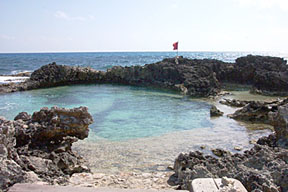 |
|
| |
There is room for an entire shipload of pirates to take the plunge in Bano del Rey photos courtesy June Hoefling
|
|
Unquestionably one of nature’s most perfect lounging pools, Bano del Rey is a perfect place to watch the sun make its first touchdown on the country of Mexico |
|
| |
|
|
|
|
| |
Called Bano del Rey – The King’s Bath – this enormous natural pool sits adjacent to the promontory of a tiny islet off the “big” island, which itself sits eight miles off the eastern coast of Mexico’s Yucatan Peninsula. The pool is huge, circular, almost completely surrounded by a rock wall tall enough to break the force of the waves but low enough to leave an unobstructed view. The water gently slopes to about a six foot depth of crystal clarity. There is a sharp demarcation line where the Caribbean Sea meets forces with the Gulf of Mexico, and from the water this line appears to lead directly to El Bano del Rey. |
|
| |
|
|
| |
|
|
| |
The Island of Women is eight watery miles – and a world away – from Cancun photo courtesy IslaMujeres.com |
|
| |
|
|
|
|
| |
Isla Mujeres (EES-la moo-HEH-res) measures just five miles long and less than one mile wide. Created by deposits of sediment from the Caribbean and Gulf currents, palms and bougainvillea cover much of its nearly flat surface. Punta Sur, on the south point, rises less than 70 feet above sea level, while the north end tapers into the sea. The Caribbean Sea slaps against the eastern coast, while the calmer waters of Bahia Mujeres laps at its western side. |
|
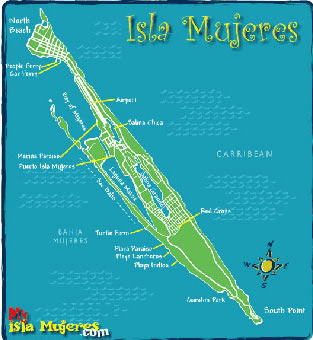 |
|
| |
Isla Mujeres is long, narrow and nearly split lengthwise by Laguna Makax map courtesy IslaMujeres.com |
|
| |
|
|
| |
Once a shelter for pirate ships, Laguna Makax now provides tranquil harbor for pleasure craft and cargo ships |
|
 |
|
Isla’s single town, El Pueblo, is located on the north end of the island adjacent to the islet, with a downtown area measuring just four blocks by six. South of downtown, the island narrows along Laguna Makax, whose placid water provided harbor to pirate ships. It then widens into scattered residential settlements. The island is home to about 14,000 folks and an amazing number of beaches, which range from wide, powdery-soft stretches of sand to rocky, water-battered shorelines. |
|
| |
|
|
|
|
|
|
| |
|
|
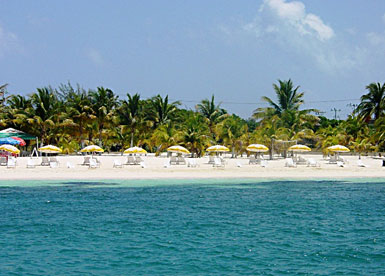 |
|
| |
The powdery white sands and shallow waters of Playa Norte have earned it a reputation as one of the best beaches in the Caribbean |
|
Palapas and sandy-floored eateries line the soft sands of Playa Norte |
|
| |
|
|
|
|
| |
Appearing like a phantom on the horizon across the Bahia Mujeres (Bay of Women) is one of Mexico’s most popular destinations for Norte Americanos. But here, I feel a world away from the mainland’s clamor of tourists and traffic. Well, it seems a world away except for a few hours a day when the “adventure outing” shuttles or passenger ferries bring day trippers from Cancun. At these times the atmosphere can get hectic at El Garrafon Park or around El Pueblo’s pier area, but it is still easy to avoid the crowds. |
|
| |
|
|
| |
 |
|
| |
Torches placed in caves in Punta Sur at the south tip of the island helped ancient Maya traders navigate their passage into Bahia Mujeres |
|
| |
|
|
| |
Isla Mujeres has been a hubbub of activity for centuries. Prior to the 1500s, Maya traders plying the Caribbean coast relied on torches placed in strategic locations on the southern tip of the island to safely navigate these waters. Fisherman prized the island’s salt supply, invaluable for preserving their catch and as a bartering commodity. Maya women came here to worship Ixchel (EE-shell), goddess of the moon, love and fertility.
It was the offerings to Ixchel—shapely, voluptuous female figures—strewn about the island that caught the attention of Francisco Cordoba and his gang of soldiers when they arrived in 1517. The partially-clad statues inspired the island’s name. After the arrival of the Spanish, the Mayas stopped using the area and the island remained mostly uninhabited.
But its strategic location did not remain unnoticed, and the 17th and 18th centuries brought French, English and Dutch pirates to its shores. Buccaneers including Henry Morgan and Jean Lafitte found Isla a perfect place to conceal their ships and spend downtime lounging in the sun. This, of course, leads to the obligatory local rumors of hidden treasure and ghostly apparitions… |
|
| |
|
|
| |
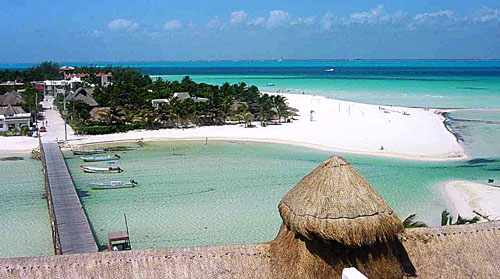 |
|
| |
Bridge to Playa Norte Just west of Playa Norte, a small wooden causeway connects the tiny islet on which Avalon Reef Club Resort & Spa sits to the main island |
|
| |
|
|
| |
When the 19th century rolled around and piracy began to decline, fishermen from the mainland and Cuba began returning to the island. Maya refugees from the Yucatan Caste War, which lasted from 1847 to 1901, found refuge on this tranquil island. And in the last quarter of the 20th century, visitors to Cancun gazed across at Isla Mujeres and wondered what undiscovered surprises awaited them across the Bay of Women. |
|
| |
|
|
| |
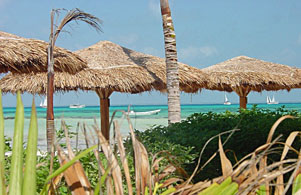 |
|
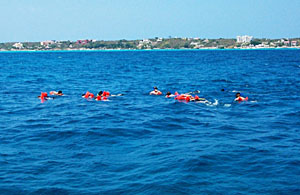 |
|
| |
All sorts of watercraft ply the waters surrounding Isla Mujeres. |
|
Isla is the launching point for dozens of prized diving spots and snorkeling reefs photo courtesy of June Hoefling |
|
| |
|
|
|
|
| |
Divers and snorkelers find unique reefs known for amazing marine life and extraordinary cave formations. Divers head to locales such as Los Manchones, Cuevones, Chital and La Bandera. On every one of their lists is a peek into Sleeping Shark Cave, about three miles off the north tip of the island. In the middle of the last century, a local lobster diver noticed a sea cave where sharks entered but didn’t seem to come out. Carlos Garcia Castilla free dove about 65 feet and discovered a school of sharks, eyes wide open and—fortunately—sound asleep! The best snorkeling can be found off the western and southern portions of the island. Strong currents and surf crashing against jagged cliffs along the eastern edge makes water play less appealing on the Caribbean side. |
|
| |
|
|
|
|
|
|
| |
A number of Maya structures once populated the landscape, including observatories, lighthouses and places of worship. Now only remnants of Ixchel’s Temple can be found, located on the southern tip of the island at Punta Sur. The view from this headland as the setting sun tints the waters of the Bay is incredible. |
|
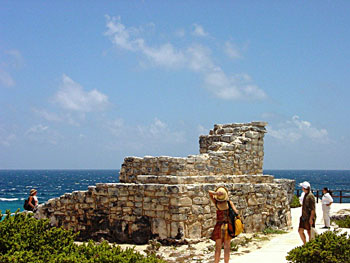 |
|
Thousands of Maya women once came to worship and leave offerings at the Temple of Ixchel, Goddess of the Moon, Love and Fertility |
|
| |
|
|
|
|
|
|
| |
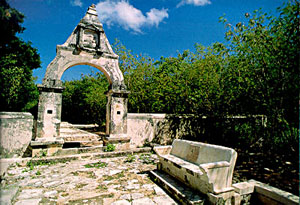 |
|
Less ruined but still in a state of major disrepair, Hacienda Mundaca is a testament to unrequited love. Born in Spain in 1825, Fermin Mundaca made his fortune in trading slaves and renting his boats to the Yucatan government to capture and enslave rebel Mayans. When slavery became too risky, he settled on Isla Mujeres. In appreciation of his “patriotic” work in helping to persecute the Maya, the Yucatan government bestowed upon him the post of Spanish Console of Isla Mujeres. Having fallen in love with a beautiful 18-year-old island girl, Mundaca built a hacienda which encompassed over 40% of the island. Most of the ancient Maya structures were dismantled to provide building material for his fantasies. As opulent as the casa and grounds proved to be, the young lady married someone else and Mundaca died lonely and mad at the age of 55. Perhaps his karma caught up with him. |
|
| |
A stone archway known as “El Paso de La Triguena” or “The Way of the Fair One” marks the path to Hacienda Mundaca photo courtesy IslaMujeres.com |
|
|
|
| |
|
|
|
|
|
| |
In sharp contrast to these centuries-old ruins, Casa Caracol is a 3-story residence that has been featured on the Travel Channel. Its owner, architect and well-known Mexican artist Octavio Ocampos, designed it in the shape of a giant conch shell. Available for rent, as seen from the water it stands like a white stucco mirage shimmering in the tropical sun. |
|
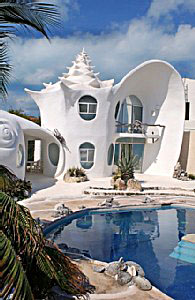 |
Casa Caracol - the Shell House - resembles a gigantic stucco conch shell
photo courtesy GreatRentals.com |
|
| |
|
|
|
|
|
| |
Most Cancun-Isla Mujeres tours head to El Garrafon Natural Reef Park. A popular snorkeling spot, even if the reef hasn’t thrived from all the tourism, the Park also offers the chance to swim with the dolphins, run a zipline, or just hang out on a hammock or lounge chair in a shady palm grove. Hunger pangs can be remedied at the snack bar or restaurant. A trail leads from the Park up to Punta Sur, past caves, an old lighthouse, through a modern sculpture garden looking somewhat out of place atop a windswept cliff, and ending at Ixchel’s Temple. |
|
| |
|
|
| |
 |
|
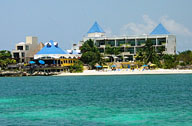 |
|
| |
Beachside snack shops and downtown eateries offer a wide assortment of delectable food, especially fresh-from-the-sea options photo courtesy IslaMujeres.com |
|
The 5-star hotel and restaurant Villa Rolandi serves a superb menu of northern Italian cuisine in a Lagoon-front setting |
|
| |
|
|
| |
Ferry visitors generally stroll around town or head to Playa Norte. A picture-perfect stretch of snow white sand, the beach slopes gently for several hundred feet into calm water. Palapas and umbrellas provide shade, and numerous eateries along the beach and “downtown” area specialize in fresh ceviche and conch. |
|
| |
|
|
| |
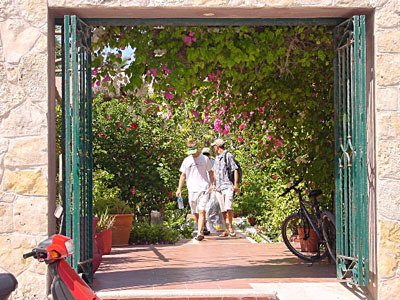 |
|
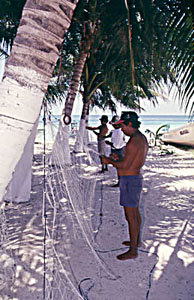 |
|
| |
Tile-paved and flower-draped courtyards might lead to tranquil lodgings or a secluded restarante
|
|
Fishing is still important on Isla, and pescadores (fishermen) often spend their evenings mending their nets photo courtesy IslaMujeres.com |
|
| |
|
|
| |
When the day trippers leave, an unruffled way of life returns to the island. Neighbors sit in front of their doorways and swap stories about the day’s events. Fishermen unhurriedly tend to their equipment. A siesta in a swaying hammock is a favorite pursuit. Non-locals lucky enough to be staying on Isla gather for alfresco dining and drinking, or wander the colorful shop stalls and bargain for prices that beat the heck out of tourist-inflated Cancun. |
|
| |
|
|
| |
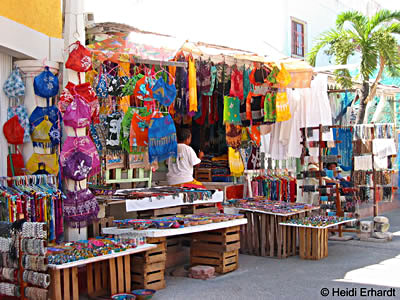 |
|
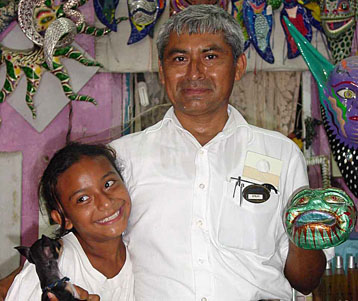 |
|
| |
The shops on Isla are generally top notch with a good selection of Mexican handicrafts at reasonable prices photo courtesy IslaMujeres.com |
|
Emilio Saso and his daughter show off a few of his alebrije creations |
|
| |
|
|
| |
In the 1930s, Pedro Linares fell extremely sick. In a feverish dream, this Mixe Indian from Oaxaca hallucinated that he was in a forest with strangely colored and shaped creatures. Amid the clamor and confusion, Pedro was only able to pick out one word, although it made no sense: alebrije (al-BREE-hay). After recovering, he began to carve his dream creatures from the local copal wood. Alebrijes have now become a part of Mexican folk art, created by a variety of artisans (and with varying degrees of craftsmanship). They can be whimsical or ferocious, but always brightly colored and never quite identifiable. Critters with monstrous features such as wings, horns, tails and fierce teeth are thought to repel bad spirits.
I have a small collection of alebrijes and when I heard an artist lived on the island who carved these fanciful items, I had to track him down. It proved very easy: Emilio Saso was working at the resort where I was staying! The resort’s GM was kind enough to give Emilio the afternoon off, and he escorted me to his workshop, just a few cobblestone streets away. It turned out that Emilio’s specialty is masks, the ideas for which he said come to him in his dreams. The walls were covered with his implausibly shaped and painted conceptions, and it was with difficulty that I narrowed the selection to just one new addition to my group. |
|
| |
|
|
| |
|
|
| |
Docks for the people and vehicle ferries unload right in the heart of El Pueblo |
|
| |
|
|
| |
Getting to Isla is easy… perhaps too easy. Passenger ferries are available from Puerto Juarez, in the northern area of Cancun. The express takes about 20 minutes, non-express about 45 minutes. A car ferry operates out of Punta Sam, five miles north of Cancun, with a 45 minute passage. More expensive passenger ferries also depart from the Playa Linda pier on Cancun Island. |
|
| |
|
|
| |
|
|
| |
Golf carts and mopeds are the practical way to motor about an island that’s only five miles long and less than one mile wide photo courtesy June Hoefling |
|
| |
|
|
| |
Two narrow roads run the length of the island, and the transport of choice is golf cart, moped or bicycle. These can be rented on the island, and there’s really no need for a car although a number of residents do have one. The variety of available accommodations cater to all pocketbooks. And don’t worry about drinking the water. In 1967, assisted by numerous local divers, the Mexican government and the Water Department installed the world’s first under-sea purified water piping system. There are a number of internet cafes, but be prepared for slow speeds. Other visitor amenities include ATMs and a currency exchange.
Yes, you can explore this tiny island in a day. On the surface. But to truly feel the way of life on Isla, plan on settling in for a few days. You won’t be bored, and you can always head to the north end, join the denizens bobbing about in the Kings Bath, and contemplate the carnival of people and events that have taken place on what might be considered a huge but inviting sandbar. |
|
| |
|
|
| |
Vicki Andersen can be reached at: skicat1@comcast.net |
|
   
|

